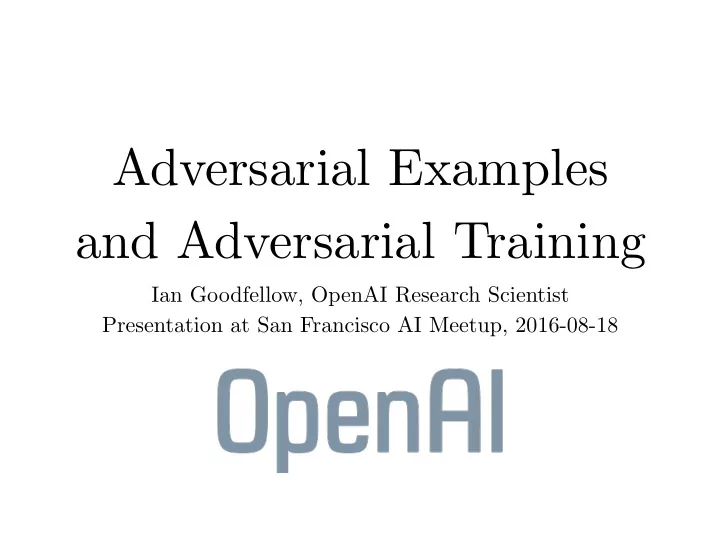

Adversarial Examples and Adversarial Training Ian Goodfellow, OpenAI Research Scientist Presentation at San Francisco AI Meetup, 2016-08-18
In this presentation • “Intriguing Properties of Neural Networks” Szegedy et al, 2013 • “Explaining and Harnessing Adversarial Examples” Goodfellow et al 2014 • “Adversarial Perturbations of Deep Neural Networks” Warde-Farley and Goodfellow, 2016 (Goodfellow 2016)
In this presentation • “Transferability in Machine Learning: from Phenomena to Black-Box Attacks using Adversarial Samples” Papernot et al 2016 • “Practical Black-Box Attacks against Deep Learning Systems using Adversarial Examples” Papernot et al 2016 • “Adversarial Perturbations Against Deep Neural Networks for Malware Classification” Grosse et al 2016 (not my own work) (Goodfellow 2016)
In this presentation • “Distributional Smoothing with Virtual Adversarial Training” Miyato et al 2015 (not my own work) • “Virtual Adversarial Training for Semi- Supervised Text Classification” Miyato et al 2016 • “Adversarial Examples in the Physical World” Kurakin et al 2016 (Goodfellow 2016)
Overview • What are adversarial examples? • Why do they happen? • How can they be used to compromise machine learning systems? • What are the defenses? • How to use adversarial examples to improve machine learning, even when there is no adversary (Goodfellow 2016)
Adversarial Examples Timeline: “Adversarial Classification” Dalvi et al 2004: fool spam filter “Evasion Attacks Against Machine Learning at Test Time” Biggio 2013: fool neural nets Szegedy et al 2013: fool ImageNet classifiers imperceptibly Goodfellow et al 2014: cheap, closed form attack (Goodfellow 2016)
Turning Objects into “Airplanes” (Goodfellow 2016)
Attacking a Linear Model (Goodfellow 2016)
Not just for neural nets • Linear models • Logistic regression • Softmax regression • SVMs • Decision trees • Nearest neighbors (Goodfellow 2016)
Adversarial Examples from Overfitting O O x x O O x x (Goodfellow 2016)
Adversarial Examples from Excessive Linearity O O O O x x x O x (Goodfellow 2016)
Modern deep nets are very piecewise linear Modern deep nets are very (piecewise) linear Rectified linear unit Maxout Rectified linear unit Maxout LSTM Carefully tuned sigmoid Carefully tuned sigmoid LSTM (Goodfellow 2016) Google Proprietary
Nearly Linear Responses in Practice (Goodfellow 2016)
Maps of Adversarial and Random Cross-Sections (collaboration with David Warde-Farley and Nicolas Papernot) (Goodfellow 2016)
Maps of Adversarial Cross-Sections (Goodfellow 2016)
Maps of Random Cross-Sections Adversarial examples are not noise (collaboration with David Warde-Farley and Nicolas Papernot) (Goodfellow 2016)
Clever Hans (“Clever Hans, Clever Algorithms,” Bob Sturm) (Goodfellow 2016)
Small inter-class distances Corrupted Clean Perturbation example example Perturbation changes the true class Random perturbation does not change the class Perturbation changes the input to “rubbish class” All three perturbations have L2 norm 3.96 This is actually small. We typically use 7! (Goodfellow 2016)
The Fast Gradient Sign Method (Goodfellow 2016)
Wrong almost everywhere (Goodfellow 2016)
Cross-model, cross-dataset generalization (Goodfellow 2016)
Cross-technique transferability (Papernot 2016) (Goodfellow 2016)
Transferability Attack Target model with unknown weights, Substitute model Train your machine learning mimicking target own model algorithm, training model with known, set; maybe non- di ff erentiable function di ff erentiable Adversarial crafting Deploy adversarial against substitute examples against the Adversarial target; transferability examples property results in them succeeding (Goodfellow 2016)
Adversarial Examples in the Human Brain These are concentric circles, not intertwined spirals. (Pinna and Gregory, 2002) (Goodfellow 2016)
Practical Attacks • Fool real classifiers trained by remotely hosted API (MetaMind, Amazon, Google) • Fool malware detector networks • Display adversarial examples in the physical world and fool machine learning systems that perceive them through a camera (Goodfellow 2016)
Adversarial Examples in the Physical World (Goodfellow 2016)
Failed defenses Generative Removing perturbation pretraining with an autoencoder Adding noise at test time Ensembles Confidence-reducing Error correcting perturbation at test time codes Multiple glimpses Weight decay Double backprop Adding noise Various at train time Dropout non-linear units (Goodfellow 2016)
Training on Adversarial Examples (Goodfellow 2016)
Adversarial Training Labeled as bird Still has same label (bird) Decrease probability of bird class (Goodfellow 2016)
Virtual Adversarial Training Unlabeled; model New guess should guesses it’s probably match old guess a bird, maybe a plane (probably bird, maybe plane) Adversarial perturbation intended to change the guess (Goodfellow 2016)
Text Classification with VAT RCV1 Misclassification Rate 8.00 7.70 7.50 7.40 7.20 7.12 7.05 7.00 6.97 6.68 6.50 6.00 Earlier SOTA SOTA Our baseline Adversarial Virtual Both Both + Adversarial bidirectional model Zoomed in for legibility (Goodfellow 2016)
Conclusion • Attacking is easy • Defending is di ffi cult • Benchmarking vulnerability is training • Adversarial training provides regularization and semi-supervised learning (Goodfellow 2016)
Recommend
More recommend